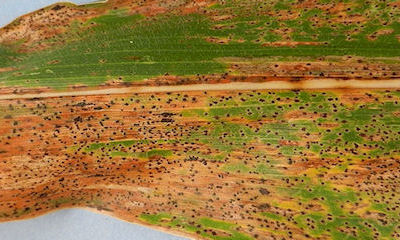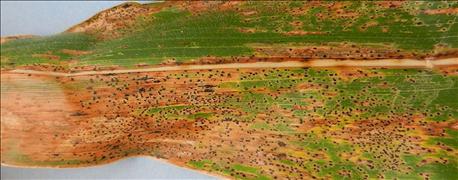December 20, 2015

Purdue University experts are now studying a new com disease that was recently found for the first time in the U.S., right here in Indiana.
Tar spot was found in a com field between Cass and Carroll counties. It has also been "spotted" in Illinois. Samples of Phyllachora maydis, a fungus that causes the disease, were examined at the Purdue Plant and Pest Diagnostic Lab. It was then confirmed by a national plant pathologist from the USDA.
Related: Learn more about tar spot in corn
This disease causes light brownish areas on the husk leaves of com ears. Black circles, called ascomata, appear afterwards on the leaf making it hard and bumpy. Affected ears are reduced in weight and may lose kernels.

What tar spot looks like: Purdue specialists were the first to confirm this disease in the U.S. (Photo courtesy of Kiersten Wise)
Tar spot spreads from lower leaves to upper leaves of the com stalk. Farmers should examine lower leaves for brown areas with ascomata at the centers. Purdue University is now asking farmers to report any fmdings next season to Extension specialists.
Two fungi are known to cause the disease: Phyllachora maydis and Monographella maydis. Serious damage normally occurs when both fungi work together. So far, only P. maydis has been reported in Indiana.
The fungus arrived in Indiana due to favorable weather, according to Purdue University's Kiersten Wise of Botany and Plant Pathology.
"While we don't know for sure how the fungus that causes tar spot arrived in the Midwest, inoculum may have been transported by a tropical storm, and we just happened to have the cool, humid conditions that favored disease development in our area," she says.
It is still unknown whether P. maydis will cause economic losses in Indiana's com production in the future. But since the fungus prefers "cool, humid conditions" in the summer, but came from more southern climates, it may not survive the upcoming winter, according to Wise.
Tar spot is most prevalent in Central and South America. Severe cases in these countries have been observed in areas with temperatures of about 60.8-68 degrees Fahrenheit. The disease has been known to cause yield losses of 30% in Mexico and 75% in Guatemala.
To learn more, contact Wise at: 765-496-2170 or: [email protected].
Hunt is a senior in Purdue University ag communications
You May Also Like




